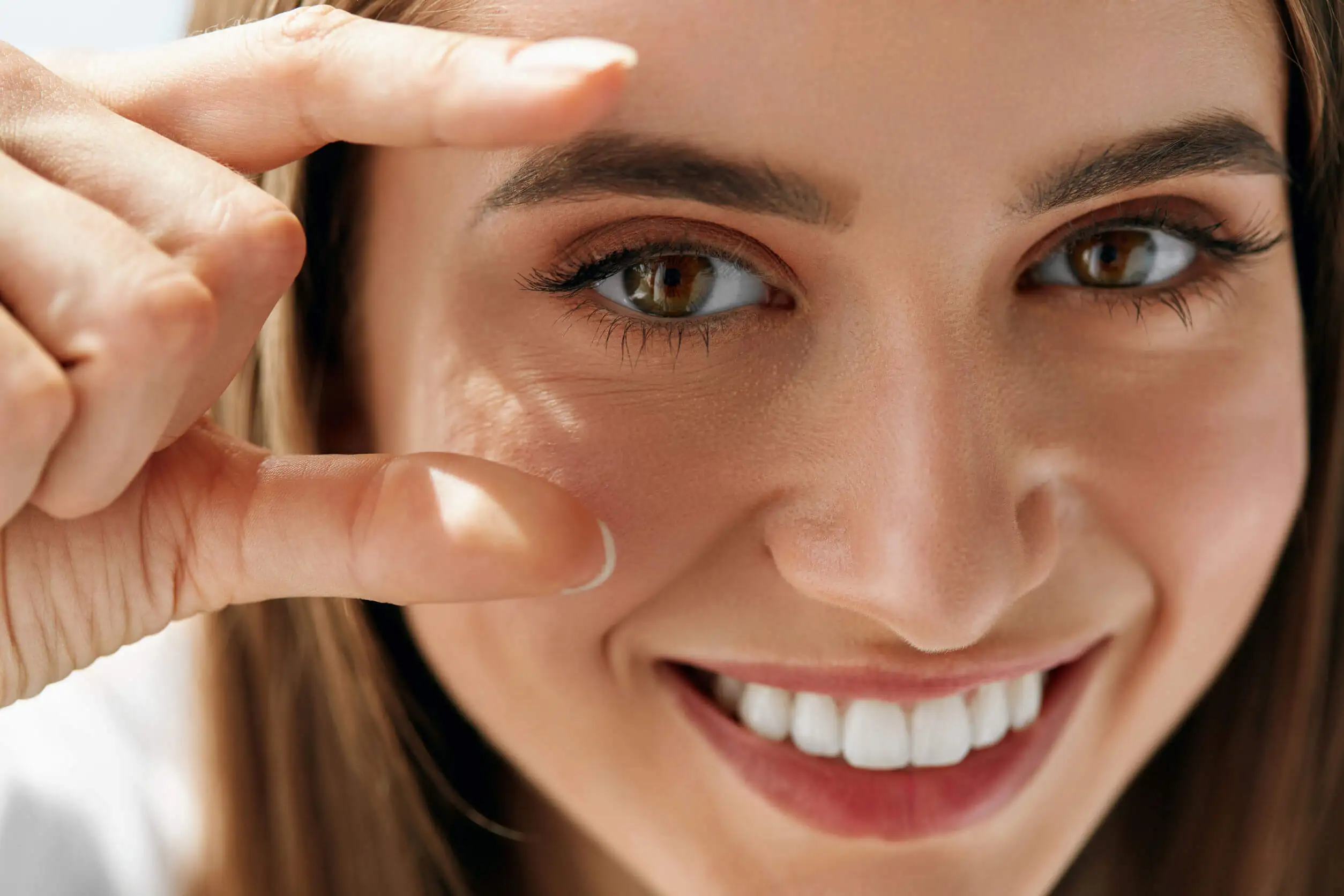Eye Contact: Secrets and Fun Facts

Eye contact is a key element in interaction. Together with movements of other parts of the face and hands, it forms part of gestural communication.
When the conversation is face-to-face, gestures or body language are more decisive in conveying meaning than words.
However, although we all recognize that eye contact is important and affects our interlocutors, we don’t always know how to establish it correctly.
What is eye contact and why is it important?
Within communication in general, there are various aspects, elements, and components. Body language is considered one of the most important elements. In fact, it’s said to constitute around 55% of the communicative experience.
In this sense, what we do with our face, hands, and the rest of the body can be more important than what we explicitly say with our mouth.
Eye contact is when two people look into each other’s eyes while talking. It can even happen when they’re silent.
However, this cannot or should not be maintained for too long either, as it could be uncomfortable for the person or for us if we’re the object of the gaze.
Eye contact is usually the starting point and requirement for communication to begin, since the best way to let a person know that we are talking to them is to look them in the eye.
In the same vein, it helps us to fulfill various functions, such as the following:
- We let the person know that we’re paying attention to him or her (or that he or she is to us);
- We accompany our words with emphasis;
- It helps us to interpret or recognize emotions as well as convey them;
- When there are several people involved, it allows us to assign speaking turns.
Researchers agree that eye contact modulates the activity of structures in the brain’s social network. Thus, the way we make eye contact can reveal our intentions and create certain reactions in others.
8 secrets and fun facts about eye contact
We all value eye contact as a key part of a dialogue, but to what extent does it affect our interlocutor or reveal things about ourselves? In the following lines, we’ll answer these questions, and we’ll do so based on studies by experts in the field. We’ve also chosen some fun facts and secrets about eye contact which will possibly surprise you.
1. Eye contact can prevent others from lying to us

We think you may also enjoy reading this article: The Keys to Good Visual Hygiene for Preventing Eye Damage
According to a study published in Consciousness and Cognition in 2018, looking directly into the eyes can reduce the dishonest behavior of our interlocutor. This could explain why most people prefer to avoid eye contact when telling a lie.
During police interrogations, it’s very important for the suspect to make eye contact in order to make their answers as honest as possible (on par with other techniques). This can be leveraged in everyday life, such as in job interviews or in conversations with friends, family, or a partner.
2. Eye contact is an indicator of our self-esteem
This is assured by a study published in Self and Identity in 2011. The researchers found that people with higher self-esteem make longer eye contact, while those with a lower self-perception tend to interrupt it more frequently.
Someone with low self-esteem often fears being judged, feels distrustful about their abilities, their physique, and their opinions, and devalues themselves in front of others. All this combines to make them prefer to make shorter eye contact compared to someone with better self-esteem.
3. Eye contact decreases our ability to persuade others
It’s often believed that it’s very important to make direct eye contact to persuade someone. This is in line with what we’ve said earlier: those who do so demonstrate self-confidence and are less likely to tell lies. However, according to research published in Psychological Science in 2013, it may also have the opposite effect in some cases.
The study found that insistence on maintaining permanent eye contact reduces persuasiveness. However, don’t let these statements be misunderstood: of course, it’s important to look at our interlocutor to persuade him or her, it’s just that when it’s done excessively it tends to play against us, as the other person may feel uncomfortable or intimidated.
4. Eye contact brings strangers closer together
A study published in Biology Letters in 2011 found that the frequency and style of gaze can bring two people who have just met closer together. Researchers believe that eye contact increases mimicry between strangers.
Therefore, it enhances the ability to mimic each other’s gestures and expressions, which in turn translates into greater intimacy. When we’re in front of someone who expresses, acts, and behaves like us, we’re more likely to feel comfortable. This has effects when going on a first date or when trying to make new friends.
5. It’s a key piece in romance

Like this article? You may also like to read: What Colors Look Good on You According to Your Skin, Hair, and Eyes
We all know that a gaze is an essential ingredient for romance. Not only is this something we’ve all confirmed on more than one occasion, but it’s backed up by science. A study published in Computers in Human Behavior in 2o2o found that eye contact in early romantic interactions reduces uncertainty and increases intimacy.
Conversely, when it’s reduced, our interlocutor tends to have more uncertainty, which he or she seeks to compensate for through questions to achieve greater intimacy and comfort. In addition, and according to evidence, eye contact has a direct role in physical arousal.
6. Eye contact increases the affection of our interlocutors
As the researchers point out, a direct gaze increases the positive affection they have for us. When we look at our interlocutors, they’re kinder to us and show us more trust; also, the treatment is more affectionate in general.
This also works for the speaker, that is, when we establish eye contact with someone, it’s because we tend to feel affection for them. On the contrary, when we’re around people who we don’t like, we tend to avoid it or reduce it to what’s strictly necessary.
7. Not all looks are the same
When we’re looked at or when we look at someone, this can happen in several ways:
- A fixed gaze: Eye contact is prolonged; it denotes attention on the person or on what he/she is saying. However, if it’s too fixed, it can signify aggressiveness or annoyance.
- A flighty gaze: A person may avoid looking another person in the eye for a variety of reasons: insecurity, embarrassment, shyness, fear, etc.
- Squinting eyelids: Squinting eyes may mean distrust, disagreement, or that the person simply doesn’t see well.
- Intermittent blinking: This may occur due to nervousness or surprise. However, there are also some people who have a tic, which makes them blink constantly.
- Eyes wide open: This occurs when something surprises us; if the pupils dilate, perhaps it’s a sign that we’re attracted to the person.
8. A lack of eye contact may denote some underlying disorder
We can’t say goodbye to this selection of curiosities without mentioning the conditions that can prevent a person from establishing eye contact. There are several explanations for this, but here are two of the most common:
- Social phobia: Experts point out that avoiding looking at people is one of the most characteristic symptoms of social anxiety disorder. People do this to avoid scrutiny and fear of being judged.
- Autism spectrum disorder (ASD): On the other hand, evidence also indicates that abnormal eye contact patterns are common in autism. These can be presented with an excessively direct gaze or, on the contrary, the avoidance of meeting others’ gazes.
Of course, not every person who has abnormal patterns suffers from one of these disorders. Some people simply choose to avoid looking when speaking because they are shy.
Speak with your eyes
Making eye contact is something that most people do automatically. While communicating, you often don’t think about increasing or decreasing it, you just do it naturally to accompany the words.
In any case, the gaze never goes unnoticed, which is something we’ve just proven based on science. The next time you talk to someone, pay attention to how their viewing patterns impact you, and vice versa. You may find that their gaze says a lot more than you thought!
All cited sources were thoroughly reviewed by our team to ensure their quality, reliability, currency, and validity. The bibliography of this article was considered reliable and of academic or scientific accuracy.
- Chen FS, Minson JA, Schöne M, Heinrichs M. In the eye of the beholder: eye contact increases resistance to persuasion. Psychol Sci. 2013 Nov 1;24(11):2254-61.
- Croes, E. A., Antheunis, M. L., Schouten, A. P., & Krahmer, E. J. The role of eye-contact in the development of romantic attraction: studying interactive uncertainty reduction strategies during speed-dating. Computers in Human Behavior. 2020; 105: 106218.
- Helminen TM, Kaasinen SM, Hietanen JK. Eye contact and arousal: the effects of stimulus duration. Biol Psychol. 2011 Sep;88(1):124-30.
- Hietanen JO, Syrjämäki AH, Zilliacus PK, Hietanen JK. Eye contact reduces lying. Conscious Cogn. 2018 Nov;66:65-73.
- Hietanen, J. K. Affective eye contact: an integrative review. Frontiers in psychology. 2018; 9: 1587.
- Senju A, Johnson MH. The eye contact effect: mechanisms and development. Trends Cogn Sci. 2009 Mar;13(3):127-34.
- Senju A, Johnson MH. Atypical eye contact in autism: models, mechanisms and development. Neurosci Biobehav Rev. 2009 Sep;33(8):1204-14.
- Schneier FR, Rodebaugh TL, Blanco C, Lewin H, Liebowitz MR. Fear and avoidance of eye contact in social anxiety disorder. Compr Psychiatry. 2011 Jan-Feb;52(1):81-7.
- Vandromme, H., Hermans, D., & Spruyt, A. Indirectly measured self-esteem predicts gaze avoidance. Self and Identity. 2011; 10(1): 32-43.
- Wang, Y., Newport, R., & Hamilton, A. F. D. C. Eye contact enhances mimicry of intransitive hand movements. Biology letters. 2011; 7(1): 7-10.
This text is provided for informational purposes only and does not replace consultation with a professional. If in doubt, consult your specialist.








